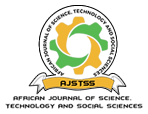The assessment of shallow well water quality in relation to well distance from the pit latrine
A case study of Moiben Sub-county, Uasin –Gishu County
DOI:
https://doi.org/10.58506/ajstss.v3i2.244Keywords:
physiochemical parameters, microbial contaminationAbstract
Informal settlements in urban areas of sub-Saharan Africa often rely heavily on shallow-dug wells for their water supply, but the wells are susceptible to contamination from various sources because most of them lack protection. The study investigated the levels of microbial quality and physicochemical parameters of shallow wells in Moiben sub- County, Uasin-Gishu County. It employed a quasi-experimental design involving laboratory experiments. A stratified sampling technique was used where sixty-two shallow wells were sampled from the five zones. This enabled analysis. The data was subjected to ANOVA and the most probable number (MPN) method was used to identify the number of total coliforms, fecal coliforms, and E. coli. The regression coefficients showed the relationship between well distance and microbial contamination with a p-value of 0.000. This implied that the distance of the shallow well from the pit-latrine is a good measure of microbial contamination. The R squared 0.728 implies the well distance can explain 72.8% of the level of microbial contamination. Test on physical parameters showed that. R squared 0.987 implying the well distance is significantly related to contamination by physiochemical parameters. In conclusion, wells located close to pit latrines consistently exhibit the highest level of contamination highlighting the role of pit latrines as a significant source of fecal pollution in groundwater. Ensuring an adequate separation distance of 50m between pit latrines and groundwater sources is important in preventing fecal contamination. Additionally, priority should be given to awareness creation, improving sanitation infrastructure, and the construction of properly engineered latrines and sewage systems.
References
Abanyie, S. K., Apea, O. B., Abagale, S. A., Amuah, E. E. Y., & Sunkari, E. D. (2023). Sources and factors influencing groundwater quality and associated health implications: A review. Emerging Contaminants, 9(2), 100207.
Aju, C. D., Achu, A. L., Mohammed, M. P., Raicy, M. C., Gopinath, G., & Reghunath, R. (2024). Groundwater quality prediction and risk assessment in Kerala, India: A machine-learning approach. Journal of Environmental Management, 370, 122616.
Chaokromthong, K., & Sintao, N. (2021). Sample size estimation using Yamane and Cochran and Krejcie and Morgan and green formulas and Cohen statistical power analysis by G* Power and comparisions. Apheit international journal of interdisciplinary social sciences and technology, 10(2), 76-86.
Cui, X., He, H., Zhu, F., Liu, X., Ma, Y., Xie, W., ... & Zhang, L. (2022). Community structure and co-occurrence network analysis of bacteria and fungi in wheat fields vs fruit orchards. Archives of Microbiology, 204(8), 453.
Gokçekuş, H., Kassem, Y., Yunusa, N., Musa, M. K., John, S. O., Usman, S., ... & Ahmad, S. M. (2020). Study on pit latrine minimum design requirement and considerations in Northern Nigeria. International Journal of Scientific & Technology Research, ISSN, 2277-8616.
Kanouo, B. M. D., Assatse, W. T., Njeudjang, K., Aretouyap, Z., & Biringamine, G. N. (2023). Assessment of the Impact of Pit Latrines on Groundwater in the Melen Slum, Cameroon. J Agric Forest Meteorol Res, 6(3), 548-560.
Kaponda, P. (2019). Drinking Water Quality and Human Dimensions: a case study of the 2017-2018 cholera outbreak in Karonga, Malawi (Doctoral dissertation, Mzuzu University).
Kisi, O., Mirboluki, A., Naganna, S. R., Malik, A., Kuriqi, A., & Mehraein, M. (2022). Comparative evaluation of deep learning and machine learning in modelling pan evaporation using limited inputs. Hydrological Sciences Journal, 67(9), 1309-1327.
KNBS. (2019). Volume I: Population by county and sub-county - kenya https://www.knbs.or.ke/wp-content/uploads/2023/09/2019-Kenya-population-and-Housing-Census-Volume-1-Population-By-County-And-Sub-County.pdf
Li, P., Karunanidhi, D., Subramani, T., & Srinivasamoorthy, K. (2021). Sources and consequences of groundwater contamination. Archives of environmental contamination and toxicology, 80, 1-10.
Lutterodt, G., Gibrilla, A., Andorful, F., Ganyaglo, S., & Oduro-Kwarteng, S. (2023). Influence of on-site sanitation on groundwater quality from large diameter wells. Groundwater for Sustainable Development, 20, 100862.
Ngatia, M. W. (2022). Effects of Anthropogenic Activities on Water Quality of Ngong River, Nairobi County, Kenya (Doctoral dissertation, University of Nairobi).
Ochiba, N. K. (2020). Assessment Of Levels Of Selected Heavy Metals In Borehole Water In Ongata Rongai, Kajiado County, Kenya (Doctoral dissertation, University Of Nairobi).
Onyango, D. O. (2023). Assessment of Water Quality From Shallow Wells in Informal Settlements in Kenya: a Case of Nyalenda Estates, Kisumu County, Kenya (Doctoral dissertation, University of Nairobi).
Osiemo, M. M., Ogendi, G. M., & M’Erimba, C. (2019). Microbial quality of drinking water and prevalence of water-related diseases in Marigat Urban Centre, Kenya. Environmental health insights, 13, 1178630219836988.
WHO. (2021). Guidelines for drinking-water quality. 38(4), 104-108.
World Health Organization, & United Nations Children's Fund. (2021). Progress on household drinking water, sanitation and hygiene 2000-2020: five years into the SDGs. World Health Organization.
World Health Organization. (2022). Water and sanitation.


